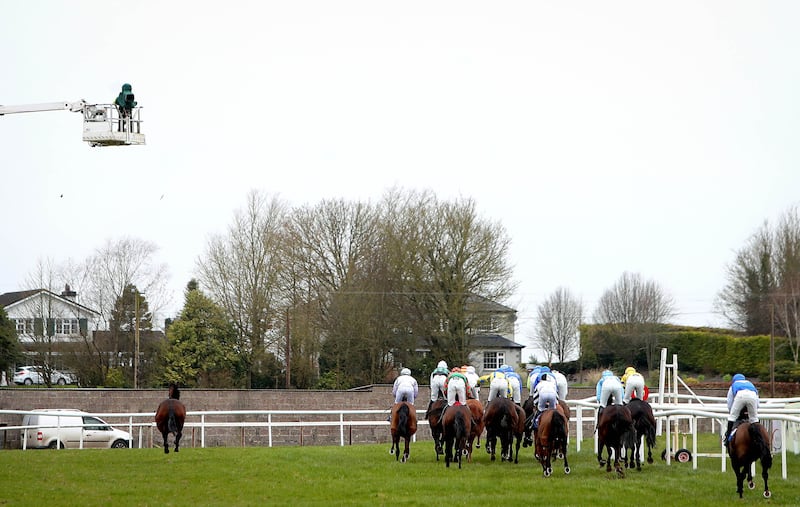Recognition that safeguards for smaller racetracks are required in a future where media rights income is based on betting turnover was crucial to an agreement that allows Ireland’s 26 racecourses sign up to a new pictures deal.
Following months of bitter wrangling that threatened to split the racecourse sector, the five tracks that make up United Irish Racecourses agreed on Friday to a €47 million per year media rights agreement.
The five-year contract negotiated with Sports Information Services and Racecourse Media Group by Horse Racing Ireland’s media rights committee starts next January and will eventually result in a revenue model linked to betting turnover at the different tracks.
The UIR courses – Thurles, Sligo, Roscommon, Kilbeggan and Limerick – broke away in January claiming trust in HRI had collapsed. They accused the semistate body of taking too big a slice of the money generated by pictures and said smaller tracks were losing out in the process.
READ MORE
UIR argued each individual track should be able to negotiate the sale of their own rights rather than the model legislated for by Government whereby negotiations are carried out En-Bloc by HRI’s committee which has members from various bodies including the Association of Irish Racecourses.
UIR maintained a betting turnover model could affect their income with greater media exposure of the more high-profile meetings inevitably resulting in more punters betting more on action at the bigger tracks.
When the deal was agreed by 21 other tracks last month, HRI announced safeguards were in place with each venue guaranteed its 2022 average per-race income in 2024.

“An easing-in provision has also been included for the first three years of the new deal to assist smaller racecourses as the model moves to a turnover basis, Virtually all racecourses are forecast to achieve higher revenues in 2025 than at present,” a statement outlined.
However, it failed to reassure UIR whose complaints were subsequently examined by both an Oireachtas Agriculture Committee and the Dáil’s Committee of Public Accounts before agreement was reached on Friday.
“I am very satisfied that HRI will monitor closely the financial exposure that smaller racecourses may encounter as the international market for selling media rights changes from a fixed fee to a turnover related model,” UIR’s chairman Pierce Molony said on Sunday.
A former Turf Club senior steward, as well as an ex-chairman of AIR, Molony, who is still a Thurles representative to AIR, was in the vanguard of the UIR rebellion. He said the situation was “complex” but that HRI had eventually been receptive to their concerns.
“As the model with media exchange companies like SIS changes from a fixed fee being paid for access to our pictures to turnover betting-related incomes, that’s the issue.
“It means the larger racecourses, with some validity, have a much larger income because their business model is far bigger.
“We were looking for safeguards from that in future and I’m comfortable that the negotiations have led to a respect for that point,” he added.
Molony said he was pleased with HRI’s willingness to implement a proposed memorandum of understanding for racecourses during future media deal negotiations, as well as a review of media rights generally.
“An overall review is required between AIR and HRI, taking the changes into account, looking at everything, at the whole business model,” he argued.
A HRI spokesman responded on Sunday that there was no particular recognition for smaller tracks and that all bids for the rights were based on a turnover model.
“HRI is always cognisant of the financial position of all racecourses, small and large, and we will be happy to keep this under close review with the AIR.
“HRI will be working closely with all racecourses and our media rights partners SIS and RMG to maximise future revenue streams under the new deal,” he said.
In other news, tributes were paid to one of Britain’s leading National Hunt owners, Paul Barber, who died at the weekend aged 80.
The businessman was the landlord of 14-times champion trainer Paul Nicholls who saddled a pair of Cheltenham Gold Cup winners owned by Barber, See More Business (1999) and Denman (2008.) More recently he was also joint-owner of the dual-King George hero, Clan Des Obeax.
Irishman Mick Fitzgerald rode See More Business to his ‘Blue Riband’ success and said on Sunday: “I was very lucky to ride a Gold Cup winner for Paul and I know what it meant to him.
“Being on top of See More Business when Paul was leading him into the winner’s enclosure that day after winning the Cheltenham Gold Cup is a memory that will live forever for me.”
He added: “He was a man who loved what Paul Nicholls did at Ditcheat, he was very proud of what Paul achieved – I know that. They were very good friends as well as Paul being a tenant and I know it meant an awful lot to him to have Paul as his trainer.”















